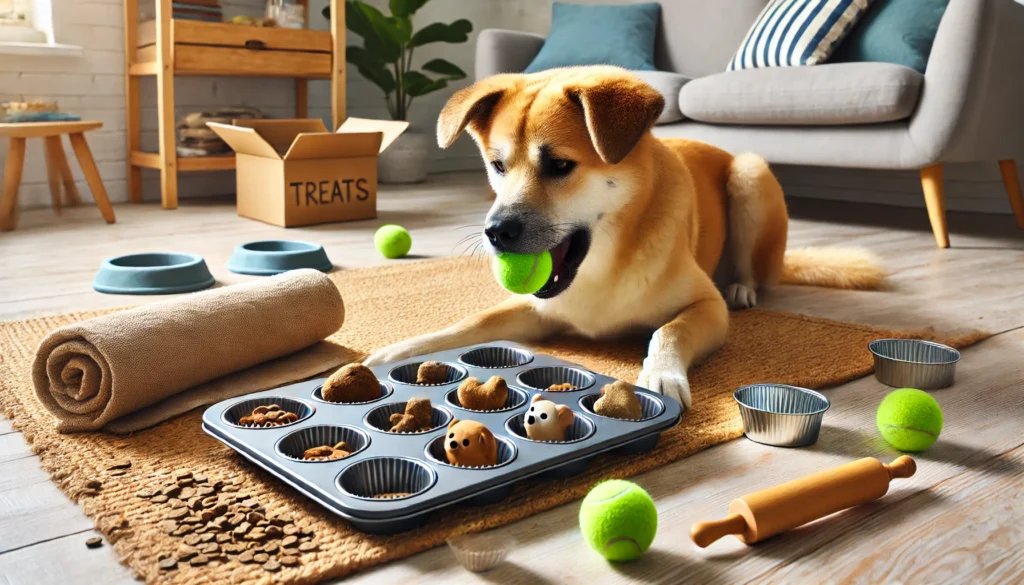Mental stimulation is just as important as physical exercise for dogs — and puzzle feeders are one of the best tools to keep their minds engaged. The good news? You don’t need to buy expensive gadgets. You can make simple, fun, and effective puzzle feeders at home using items you already have.
Here’s how to create safe, interactive feeding games for your dog using common household objects.
Why Puzzle Feeders Are Great for Dogs
Before we get into the DIY ideas, let’s understand their value:
- Slow down fast eaters: Helps prevent bloating and indigestion.
- Reduce boredom: Keeps dogs engaged and mentally active.
- Burn energy indoors: Especially helpful for high-energy breeds.
- Build confidence: Helps nervous dogs through independent play.
- Prevent destructive behavior: Gives them a safe outlet for problem-solving instincts.
Puzzle feeders turn mealtime into a game — and dogs love it.
Safety Tips Before You Begin
- Always supervise your dog the first few times they use a new DIY feeder.
- Choose non-toxic, clean, and dog-safe materials (avoid sharp edges or tiny loose parts).
- Wash or replace items as needed to maintain hygiene.
- Adjust complexity based on your dog’s age, breed, and personality.
Now, let’s get crafting!
DIY Puzzle Feeder Ideas
1. Muffin Tin + Tennis Balls
What you need:
- A 6- or 12-cup muffin tin
- Small treats or kibble
- Tennis balls (one for each cup)
How to use:
- Place kibble or small treats in each muffin cup.
- Cover each one with a tennis ball.
- Your dog must move the balls to reach the food underneath.
Why it works: It’s simple, encourages nose work, and helps build persistence.
2. Towel Roll-Up Treat Mat
What you need:
- A clean towel or old blanket
- Your dog’s kibble or small treats
How to use:
- Scatter the kibble along the towel.
- Roll it up tightly and tuck the ends.
- Let your dog unroll it to find the food.
Why it works: It taps into natural foraging behavior and slows down eating.
3. Plastic Bottle Spinner
What you need:
- An empty plastic water bottle
- A string or wooden spoon
- Dry kibble
How to use:
- Cut small holes in the sides of the bottle (big enough for kibble to fall out).
- Hang it by a string or balance it through a box so it spins freely.
- Fill with kibble and let your dog paw or nudge it to dispense food.
Why it works: It adds motion and unpredictability, increasing excitement and focus.
4. Egg Carton Treasure Hunt
What you need:
- A clean egg carton (paper preferred)
- Treats or kibble
How to use:
- Place treats inside the carton cups.
- Leave some open, and close a few others with the lid or crumpled paper.
- Let your dog explore and figure out how to open them.
Why it works: It encourages problem-solving and engages scent tracking.
5. Cardboard Box Puzzle
What you need:
- A small cardboard box
- Toilet paper rolls, small boxes, and crumpled paper
- Kibble or treats
How to use:
- Fill the base of the box with layers of toilet paper rolls or paper.
- Hide kibble deep inside the layers.
- Close the lid partially or leave it open for beginners.
Why it works: Dogs have to dig, sniff, and search — a full sensory experience.
Bonus: Frozen Yogurt Kibble Pops
What you need:
- Plain, unsweetened yogurt (dog-safe)
- Kibble or soft treats
- Ice cube tray
How to use:
- Mix yogurt with kibble.
- Pour into an ice cube tray and freeze.
- Offer one cube as an enrichment treat on hot days.
Why it works: Cooling, tasty, and requires licking — which is naturally soothing.
Tips to Keep DIY Feeding Fun
- Rotate puzzles: Don’t use the same one every day. Keep things fresh.
- Start easy, then build: Let your dog win to stay motivated, then gradually add complexity.
- Use part of their daily meal: Instead of extra treats, use puzzle feeders for breakfast or dinner.
- Clean after each use: Especially if using fabric, yogurt, or raw food.
Enrichment Doesn’t Have to Be Expensive
Puzzle feeders aren’t just toys — they’re mental workouts. With a few household items and a bit of creativity, you can challenge your dog’s mind, reduce boredom, and add variety to their daily routine.
Best of all? These DIY activities are low-cost, adjustable to any living space, and deeply rewarding for both dog and owner.






